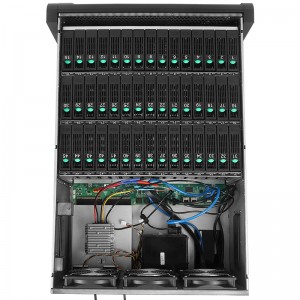Server Case
In the world of computing, server case plays a key role in determining the overall performance and efficiency of the server. A server case, often referred to as a chassis, is the enclosure that houses the server components, including the motherboard, power supply, storage drives, and cooling system. The design and quality of a server chassis can significantly impact the performance of the server case, so it is an important consideration for businesses and IT professionals.
One of the main functions of a server case is to provide adequate cooling for the components inside. High-performance servers generate a lot of heat, which, without proper ventilation, can cause thermal throttling, performance degradation, or even hardware failure. A well-designed server chassis employs efficient airflow management and is typically equipped with multiple fans and strategically placed vents to ensure optimal cooling. This not only improves the performance of your server case, but also extends the life of the components within it.
Additionally, the size and layout of the server case will affect the ease of maintenance and upgrades. A spacious server case allows for better cable management and easier access to components, which is critical for routine maintenance and troubleshooting. This accessibility can reduce downtime, thereby improving the overall performance of server chassis in commercial environments.
Additionally, the material and build quality of your server case will also affect its durability and noise levels. High-quality materials provide better insulation from vibration and noise, creating a more favorable working environment. This is especially important in data centers where multiple servers are running simultaneously.
A server case is more than just a protective shell; it is an essential component that directly affects the performance of the server case. By investing in a high-quality server case with effective cooling solutions and thoughtful design, organizations can ensure their servers operate at peak efficiency, ultimately increasing productivity and reliability.
-

Network storage enterprise high-intensity computing server hot swap case
Product Description 1. What is network storage? How does it benefit business? Network storage refers to the centralized storage of digital data that can be accessed by multiple users and devices over the network. It benefits businesses by providing scalable and secure storage solutions for their data, allowing them to easily access and share information across the organization. 2. What is high-intensity computing and how is it used in an enterprise environment? Intensive computing, also known... -

High-end manufacturing hot-swappable rack-mounted 2U server chassis
Product Description Introducing our latest product, a high-end manufactured hot-swappable rack-mounted 2U server chassis. This innovative technology is engineered and engineered to meet the needs of modern data centers and enterprises looking for efficient and reliable server solutions. The heart of this server chassis is its hot-swappable capabilities. Its ability to instantly replace components without powering down the system provides IT administrators with unprecedented flexibility and co... -

Made in China NVR hot-swappable FIL server 2u case
Introduce In recent years, China has gained a reputation for its leadership in technological manufacturing, providing high-quality products at competitive prices. One of the cutting-edge developments is the hot-swappable FIL server 2U chassis for network video recorders (NVRs). In this blog, we’ll take a closer look at the great features and benefits of this innovative product made in China. Unleash the power of hot-swap functionality The NVR’s hot-swappable capabilities are a game-changer in...

